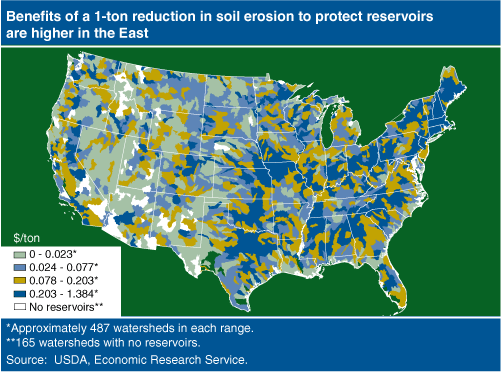Soil Conservation Preserves Reservoir Benefits Nationwide
- by LeRoy Hansen
- 6/1/2008
Over 75,000 reservoirs in the 48 contiguous States provide recreation, scenic beauty, flood control, fish and wildlife habitat, water supplies, hydroelectric power, and other benefits. But over time, sediment settling to the bottom of reservoirs reduces their water-holding capacity and the quality of benefits they provide. Agricultural runoff is a major source of reservoir sediment in many areas of the country. Sediment washed from fields moves down streams and settles in lakes and reservoirs. Therefore, steps to reduce soil erosion on the Nation’s farms and ranches can protect the benefits provided by reservoirs.
A recent analysis by ERS estimates that the value of a 1-ton reduction in agricultural soil erosion and the subsequent reduction in reservoir sedimentation is as high as $1.38 per ton. The analysis provides per ton benefit values for all of the 2,111 watersheds in the 48 contiguous States. Benefit values across the country vary because of site-specific differences in the physical effects, that is, the quantity of sediment deposited due to a 1-ton change in soil erosion, and the value people place on changes in reservoir benefits. In general, as the number of reservoirs within a watershed increases, physical effects increase. As the size of the population affected in a region increases, the total value of benefits increases. Consequently, benefit values tend to be higher in the East.
The ERS estimates of the benefits of soil conservation, in terms of their impact on reservoirs, are derived from two models. The first links changes in soil erosion to changes in reservoir sedimentation, using data on reservoir characteristics, sedimentation rates, and erosion rates. The second model links changes in the value of reservoir benefits to changes in reservoir sedimentation and is estimated with data on reservoir characteristics and, indirectly, dredging costs. The analysis estimates a benefit model using cost data because it is reasonable to assume that the benefits of dredging a reservoir are sufficient to at least cover dredging costs.
Although estimates of the benefits of a 1-ton reduction in erosion amount to less than $0.20 per ton in 80 percent of the watersheds, the total value of soil conservation with regard to reservoir benefits is substantial. For example, through a variety of public and private initiatives, soil erosion in 1997 was 640 million tons less than in 1982. The public benefit for the subsequently lower level of reservoir sedimentation is estimated to be $154 million. Of course, this is just one of many soil conservation benefits.
This article is drawn from:
- The Value of the Reservoir Services Gained with Soil Conservation. (2007). Land Economics. 83(3): 285-301..



